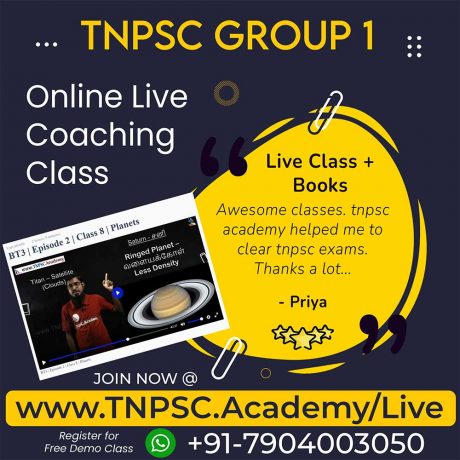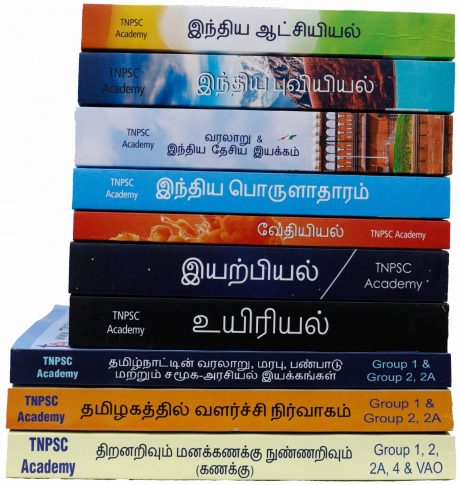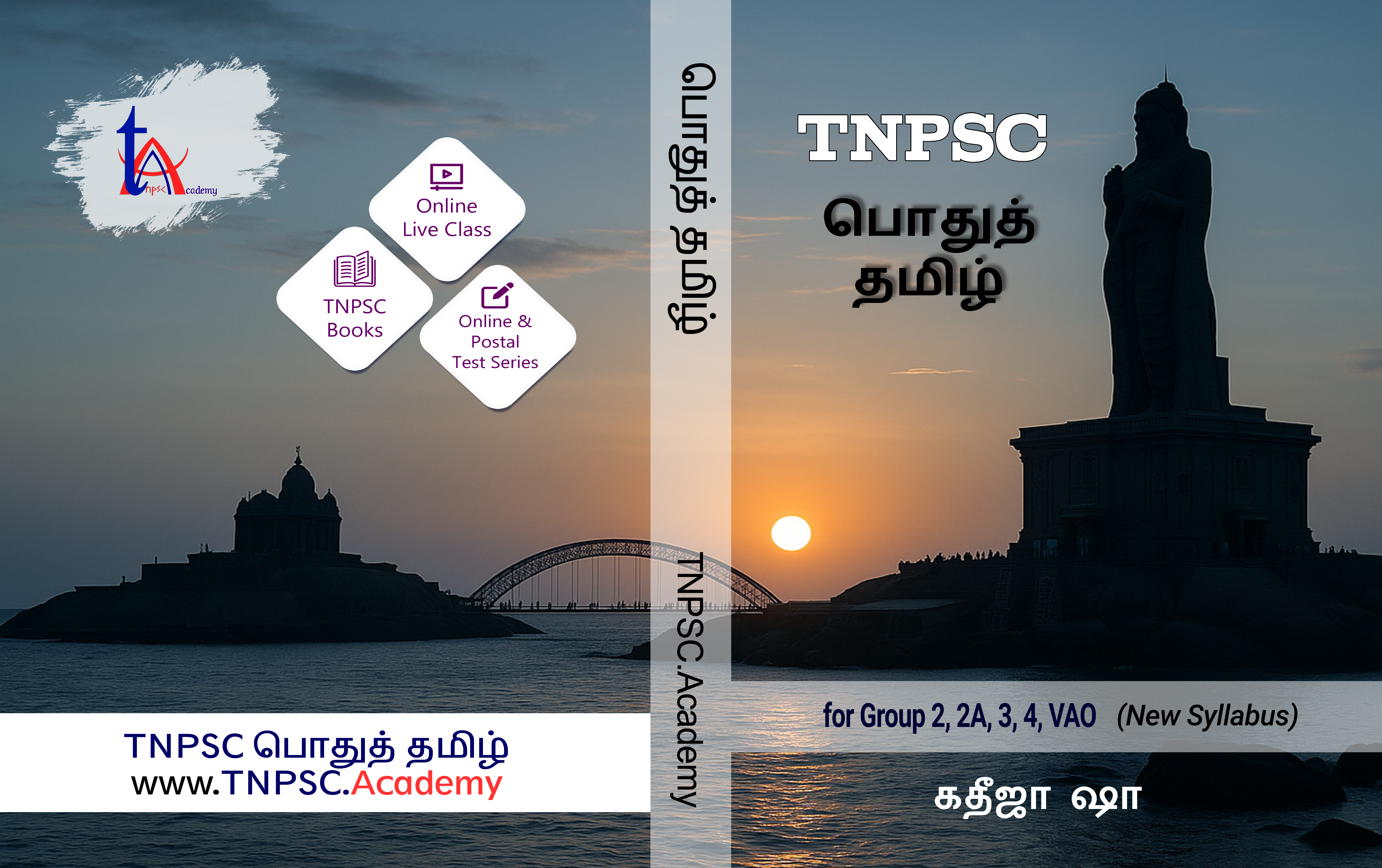Group 1 Courses in English & Tamil
Free Current Affairs Daily Quiz
Current AffairsDaily TestFreeGroup 1Group 2Group 2AGroup 4Test SeriesTNUSRBVAODaily Quiz for Day to Day Current Affairs in both English & தமிழில்
4.7
FREE
Free Online Test
Daily TestFreeGeneral StudiesTest SeriesGroup 1, Group 2, Group 2A, Group 4 and VAO
FREE
TNPSC Live Classes | Online Batch | Group 1, 2, 2A, 4, VAO (Prelims)
General StudiesOnline Live Classes with Test Series | ஆன்லைன் நேரலை...
5
₹12,500.00 – ₹18,250.00
TNPSC Group 1 - 2020 Free Revision Module
General StudiesTNPSC Group 1 2020 FREE Revision cum Guidance based video classes (In English &...
FREE
TNPSC தமிழ்நாட்டின் வரலாறு, மரபு, பண்பாடு மற்றும் சமூக-அரசியல் இயக்கங்கள் - Group 1, 2, 2A, 4 & VAO
FreeGeneral StudiesHistory Culture HeritageGroup 1, Group 2, Group 2A, Group 4 and VAO
5
FREE
TNPSC தமிழகத்தில் வளர்ச்சி நிர்வாகம் - Group 1, 2, 2A, 4 and VAO
Development Administration in TNFreeGeneral StudiesGroup 1, Group 2, Group 2A, Group 4 and VAO
FREE
TNPSC History, Culture, Heritage & Socio-Political Movements in Tamil Nadu - Group 1, 2, 2A, 4 and VAO
FreeGeneral StudiesHistory Culture HeritageGroup 1, Group 2, Group 2A, Group 4 and VAO
4.7
FREE
TNPSC Development Administration in Tamil Nadu - Group 1, 2, 2A, 4 and VAO
Development Administration in TNFreeGeneral StudiesGroup 1, Group 2, Group 2A, Group 4 and VAO
5
FREE
TNPSC இந்திய ஆட்சி அமைப்பு - Group 1, 2, 2A, 4 and VAO
FreeGeneral StudiesPolityGroup 1, Group 2, Group 2A, Group 4 and VAO
FREE
TNPSC இந்திய பொருளாதாரம் - Group 1, 2, 2A, 4 and VAO
EconomyFreeGeneral StudiesGroup 1, Group 2, Group 2A, Group 4 and VAO
4
FREE
TNPSC புவியியல் - Group 1, 2, 2A, 4 and VAO
FreeGeneral StudiesGeographyGroup 1, Group 2, Group 2A, Group 4 and VAO
FREE
TNPSC Biology - Group 1, 2, 2A, 4 and VAO
BiologyFreeGeneral StudiesGroup 1, Group 2, Group 2A, Group 4 and VAO
5
FREE
TNPSC History - Group 1, 2, 2A, 4 and VAO
FreeGeneral StudiesHistoryGroup 1, Group 2, Group 2A, Group 4 and VAO
FREE
TNPSC Indian National Movement - Group 1, 2, 2A, 4 and VAO
FreeGeneral StudiesIndian National MovementGroup 1, Group 2, Group 2A, Group 4 and VAO
5
FREE
TNPSC Physics - Group 1, 2, 2A, 4 and VAO
FreeGeneral StudiesPhysicsGroup 1, Group 2, Group 2A, Group 4 & VAO.
FREE
TNPSC Chemistry - Group 1, 2, 2A, 4 and VAO
ChemistryFreeGeneral StudiesGroup 1, Group 2, Group 2A, Group 4 and VAO
FREE
TNPSC Indian Polity - Group 1, 2, 2A, 4 and VAO
FreeGeneral StudiesPolityGroup 1, Group 2, Group 2A, Group 4 and VAO
5
FREE
TNPSC Geography - Group 1, 2, 2A, 4 and VAO
FreeGeneral StudiesGeographyGroup 1, Group 2, Group 2A, Group 4 and VAO
5
FREE
TNPSC Economy - Group 1, 2, 2A, 4 and VAO
EconomyFreeGeneral StudiesGroup 1, Group 2, Group 2A, Group 4 and VAO
4
FREE
TNPSC வரலாறு - Group 1, 2, 2A, 4 and VAO
FreeGeneral StudiesHistoryGroup 1, Group 2, Group 2A, Group 4 and VAO
FREE
TNPSC இந்திய தேசிய இயக்க வரலாறு - Group 1, 2, 2A, 4 and VAO
FreeGeneral StudiesIndian National MovementGroup 1, Group 2, Group 2A, Group 4 and VAO
FREE
TNPSC உயிரியல் - Group 1, 2, 2A, 4 and VAO
BiologyFreeGeneral StudiesGroup 1, Group 2, Group 2A, Group 4 and VAO
FREE
TNPSC இயற்பியல் - Group 1, 2, 2A, 4 and VAO
FreeGeneral StudiesPhysicsGroup 1, Group 2, Group 2A, Group 4 & VAO.
5
FREE
TNPSC வேதியியல் - Group 1, 2, 2A, 4 and VAO
ChemistryFreeGeneral StudiesGroup 1, Group 2, Group 2A, Group 4 and VAO
FREE
TNPSC Aptitude and Reasoning (Maths)
Apps ReasoningFreeGeneral StudiesGroup 1, Group 2, Group 2A, Group 4 and VAO
5
FREE
TNPSC பொதுத் தமிழ்
FreeGeneral StudiesGeneral TamilTNPSC பொதுத் தமிழ் - www.TNPSC.Academy இன் பொது...
4.6
FREE






